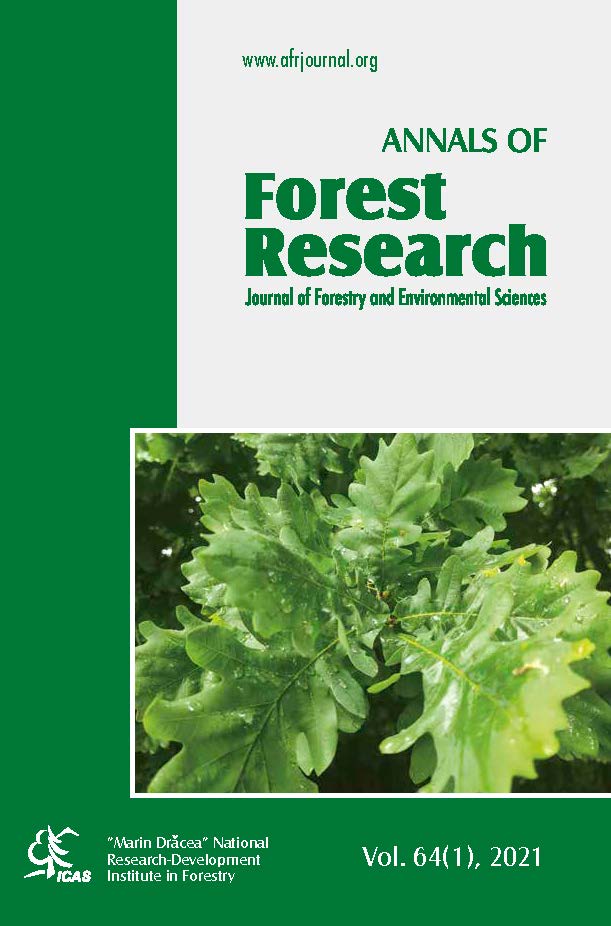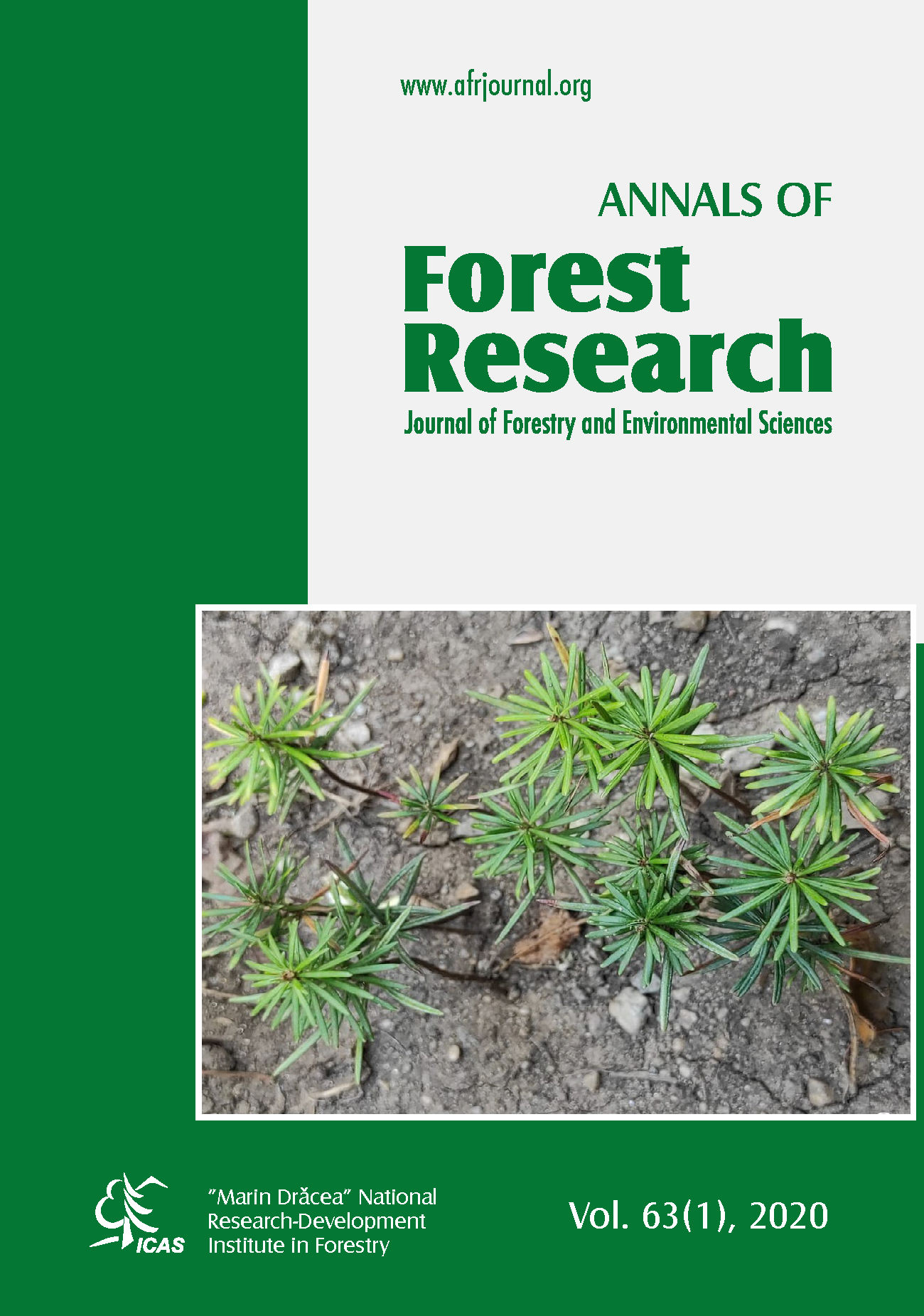Comparison of various growth functions for predicting long-term stand development associated with different initial spacing in 64-year-old Japanese cedar (Cryptomeria japonica (L.f.) D. Don) plantations
DOI:
https://doi.org/10.15287/afr.2020.1989Keywords:
initial spacing, Japanese cedar (Cryptomeria japonica), plantations, the Richards growth function, repeated measures analysis of varianceAbstract
Establishing a plantation with varied distances between trees is one way to control stand density. Understanding how stand growth patterns are influenced by initial spacing can help maximize growth and yield. The purpose of this study was to examine the long-term effects of different patterns of initial tree spacing on stand development. A spacing trial with 5 initial distances, namely, treatments I: 1×1 m, II: 2×2 m, III: 3×3 m, IV: 4×4 m and V: 5×5 m, was installed in 1950 on Japanese cedar (Cryptomeria japonica) plantations in central Taiwan, managed by the Experimental Forest of National Taiwan University. Each treatment had 3 repeated plots, and all the plots were surveyed from 1955 to 2014, with 8 records for each time series. We simultaneously employed 6 growth functions to predict stand basal area growth for each plot and assessed their predictability using the root mean square error (RMSE) as a criterion. Consequently, a total of 15 plots covering all the treatments, each with 6 RMSEs resulting from various models, were obtained. The repeated measures analysis of variance approach was adopted to compare predictability among models. The Richards growth function stood out from all the other models. As a result, this model was used to analyze stand development following different initial spacing. We found that the predicted curves could effectively exhibit the growth patterns resulting from different initial spacing. Moreover, the parameters help explain some characteristics of stand development, such as the growth potential and the maximum growth rate achieved (tmax). As a result, a clear trend emerged, showing that the growth potential increased, whereas the tmax decreased with decreasing initial spacing. These results provided valuable information for managing the stand density of this conifer.References
Baldwin V. C. Jr., Peterson K. D., Clark A. III, Ferguson R. B., Strub M. R., Bower D. R., 2000. The effects of spacing and thinning on stand and tree characteristics of 38-year-old loblolly pine. Forest Ecology and Management 137: 91–102. https://doi.org/10.1016/S0378-1127(99)00340-0
Cheng C. H., Hung C. Y., Chen C. Peng., Pei C. W., 2013. Biomass carbon accumulation in aging Japanese cedar plantations in Xitou, central Taiwan. Botanical Studies 54:60. doi:10.1186/1999-3110-54-60. https://doi.org/10.1186/1999-3110-54–60
Chiu C. M., Nigh G., Chien C. T., Ying C. C., 2010. Growth patterns of plantation-grown Taiwania cryptomerioides following thinning. Australian Forestry 73: 246–253. https://doi.org/10.1080/00049158.2010.10676335
Clutter J. L., Fortson J. C., Pienaar L.V., Brister G. H., Bailey R. L., 1983. Timber management: A quantitative approach. John Wiley & Sons, Inc. 333 p.
Draper N. R., Smith H., 1981. Applied Regression Analysis. Second Edition. New York: Wiley.
Fukuda M., Iehara T., Matsumoto M., 2003. Carbon stock estimates for sugi and hinoki forests in Japan. Forest Ecology and Management 184(1-3):1–16. https://doi.org/10.1016/S0378-1127(03)00146-4
Gizachew B., Brunner A., Øyen B., 2012. Stand responses to initial spacing in Norway spruce plantations in Norway. Scandinavian Journal of Forest Research 27(7): 637–648. https://doi.org/10.1080/02827581.2012.693191
Ito S., Osumi S., 1984. An analysis of the basal area growth in even aged pure stands based on the Richards growth function. Journal of Japanese Forest Society 66: 99–108.
Kitagawa R., Ueno M., Masaki T., 2018. Initial effects of thinning and concomitant disturbance on the understory woody community in Japanese cedar plantation. Journal of Forest Research 23(2):120–128. https://doi.org/10.1080/13416979.2018.1430653
Lam T. Y., Guan B. T., 2020. Modeling stand basal area growth of Cryptomeria japonica D. Don under different planting densities in Taiwan. Journal of Forest Research 25(3): 174–182. https://doi.org/10.1080/13416979.2020.1733171
Lin C. J., Lin F. C., 2003. Ring characteristics of 95-year old Japanese cedar plantation trees grown in Taiwan. Scientific Research and Essays 8(8): 315–324. https://doi.org/10.5897/SRE12.132
Liu Y. C., Lu F. Y., Ou C. H., 1994. Trees of Taiwan. Monographic Publication No. 7. College of Agriculture, National Chung-Hsing University, Taichung, Taiwan. R.O.C, pp. 63–64 (in Chinese).
Masaki T., Mori S, Kajimoto T., Hitsuma G., Sawata S., Mori M., Osumi K., Sakurai S., Seki T., 2006. Long-term growth analyses of Japanese cedar trees in a plantation: neighborhood competition and persistence of initial growth deviations. Journal of Forest Research 11(4): 217–225. https://doi.org/10.1007/s10310-005-0175-6
Nishizono T., Tanaka K., Hosoda K., Awaya Y., Oishi Y., 2008. Effects of thinning and site productivity on culmination of stand growth: results from long-term monitoring experiments in Japanese cedar (Cryptomeria japonica D. Don) forests in northeastern Japan. Journal of Forest Research 13(5): 264–274. https://doi.org/10.1007/s10310-008-0082-8
Richards F.J., 1959. A flexible growth function for empirical use. Journal of Experimental Botany, 10: 290-300. https://doi.org/10.1093/jxb/10.2.290
Pienaar L. V., Turnbull K. J., 1973. The Chapman-Richards generalization of Von Bertalanffy's growth model for basal area growth and yield in even-aged stands. Forest Science. 19(1):2–22. https://doi.org/10.1093/forestscience/19.1.2
Shih C. F., Liu K. F., Chen F. S., 1997. Spacing study in Cryptomeria plantation – 46 years old result. Journal of the Experimental Forest of National Taiwan University 11 (2): 81–109. (in Chinese with English summary).
TFB, 2020. Available at http://www.forest.gov.tw. Taipei, Taiwan: Taiwan Forestry Bureau (TFB). Accessed January 2020.
The Experimental Forest, College of Bio-Resources and Agriculture, National Taiwan University 2018. http://www.exfo.ntu.edu.tw. Accessed January 2018.
Wang D. H., Chung C. H., Hsieh H. C., Tang S. C., Chen T. H., 2012. Site index model for Sugi plantation in Zenlen area, Taiwan. Taiwan Journal of Forest Science 27: 299–307.
Yen T. M., 2015. Relationships of Chamaecyparis formosensis crown shape and parameters with thinning intensity and age. Annals of forest research 58(2): 323–332. https://doi.org/10.15287/afr.2015.408
Yen T. M., 2016. Culm height development, biomass accumulation and carbon storage in an initial growth stage for a fast-growing moso bamboo (Phyllostachys pubescens). Botanical Study 57. https://doi.org/10.1186/s40529-016-0126-x
Yen T. M., Huang K. L., Li L. E., Wang C. H., 2020. Assessing carbon sequestration in plantation forests of important conifers based on the system of permanent sample plots across Taiwan. Journal of Sustainable Forestry 39(4): 392–406. https://doi.org/10.1080/10549811.2019.1673181
Young Y. C., 1975. Study in the growth and harvest of Japanese cedar in National Taiwan University Experimental Forest. National Taiwan University Experimental Forest Research Report. No. 116 (in Chinese).
Downloads
Published
Issue
Section
License
All the papers published in Annals of Forest Research are available under an open access policy (Gratis Gold Open Access Licence), which guaranty the free (of taxes) and unlimited access, for anyone, to entire content of the all published articles. The users are free to "read, copy, distribute, print, search or refers to the full text of these articles", as long they mention the source.
The other materials (texts, images, graphical elements presented on the Website) are protected by copyright.
The journal exerts a permanent quality check, based on an established protocol for publishing the manuscripts. The potential article to be published are evaluated (peer-review) by members of the Editorial Board or other collaborators with competences on the paper topics. The publishing of manuscript is free of charge, all the costs being supported by Forest Research and Management Institute.
More details about Open Access:
Wikipedia: http://en.wikipedia.org/wiki/Open_access






